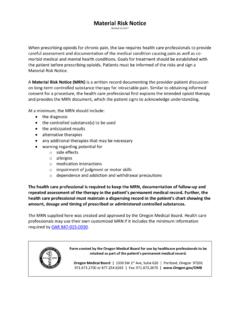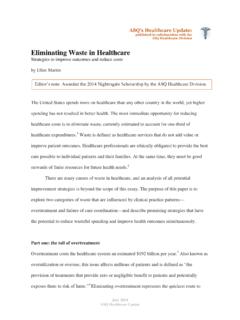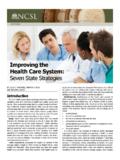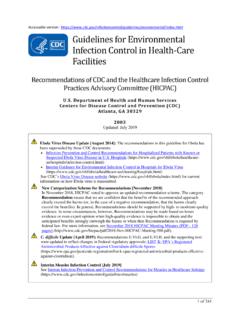Transcription of CHAPTER 13 Health Care Facilities and MEDICAL GAS and ...
1 CHAPTER 13. Health care Facilities and MEDICAL GAS and Vacuum SYSTEMS. Part I Special Requirements for Health care Facilities . Application. Construction and equipment requirements shall be applied only to new construction and new equipment, except as modified in individual chapters. Only the altered, renovated, or modernized portion of an existing system or individual component shall be required to meet the installation and equipment requirements stated in this standard code. If the alteration, renovation, or modernization adversely impacts existing performance requirements of a system or component, additional upgrading shall be required. [NFPA. 99 ]. This CHAPTER applies to the special fixtures and systems in Health care Facilities and to the special plumbing requirements for such Facilities .
2 Other plumbing in such Facilities shall comply with other applicable sections of this code. This CHAPTER shall not apply to breathing air replenishment (BAR) systems. MEDICAL Gas and Vacuum Piping Systems Installation Requirements. The installation of MEDICAL gas and vacuum piping systems shall be in accordance with the requirements of this CHAPTER and/or the appropriate standards adopted in this code by the Authority Having Jurisdiction State Plumbing Board. For additional standards, see Table 14-1. The installation of individual components shall be made in accordance with the instructions of the manufacturer. Such instructions shall include directions and information deemed by the manufacturer to be adequate for attaining proper operation, testing, and maintenance of the MEDICAL gas and vacuum systems.
3 Copies of the manufacturer's instructions shall be left with the system owner. [NFPA 99 ]. [NFPA 99 ]. Protrusions from Walls. Drinking fountain control valves shall be flush-mounted or fully recessed when installed in corridors or other areas where patients are transported on a gurney, bed, or wheelchair. Piping exposed in corridors and other areas where subject to physical damage from the movement of carts, stretchers, portable equipment, or vehicles shall be protected. [NFPA 99 ] [NFPA 99 ]. Psychiatric Patient Rooms. Piping and drain traps in psychiatric patient rooms shall be concealed. Fixtures and fittings shall be resistant to vandalism. Locations for Ice Storage. Ice makers or ice storage containers shall be located in nursing stations or similarly supervised areas to minimize potential contamination.
4 1. Sterilizers. General. The requirements of this section apply to sterilizers and bedpan steamers. Such equipment shall be installed in accordance with this code and the manufacturer's installation instructions. Indirect waste Connections. waste drainage from sterilizers and bedpan steamers shall be connected to the sanitary drainage system through an airgap in accordance with this CHAPTER and CHAPTER 8. The size of indirect waste piping shall be not less than the size of the drain connection on the fixture. Each such indirect waste pipe shall not exceed fifteen (15). feet (4,572 mm) in length and shall be separately piped to a receptor. Such receptors shall be located in the same room as the equipment served.
5 Except for bedpan steamers, such indirect waste pipes shall not require traps. A trap having a seal of not less than three (3). inches (76 mm) shall be provided in the indirect waste pipe for a bedpan steamer. Vapor Vents and Stacks for Sterilizers. General. When a sterilizer has provision for a vapor vent and such a vent is required by the manufacturer, the vent shall be extended to the outdoors above the roof. Sterilizer vapor vents shall be installed in accordance with the manufacturer's instructions and shall not be connected to any drainage system vent. Aspirators. (See Section , Water Inlets to Water Supplied Aspirators.) Provisions for aspirators or other water-supplied suction devices shall be installed only with the specific approval of the Authority Having Jurisdiction building official.
6 Where aspirators are used for removing body fluids, they shall include a collection container to collect liquids and solid particles. Aspirators shall indirectly discharge to the sanitary drainage system through an airgap in accordance with CHAPTER 8. The potable water supply to an aspirator shall be protected by a vacuum breaker or equivalent backflow protection device in accordance with Section Part II MEDICAL Gas and Vacuum Systems. Application. The provisions herein shall apply to the installation and testing of MEDICAL gas and vacuum piping in hospitals, clinics, and other Health care Facilities . The purpose of this CHAPTER is to provide requirements for the installation and testing of MEDICAL gas and MEDICAL vacuum systems, from the central supply system to the station outlets or inlets.
7 Wherever the terms MEDICAL gas or vacuum occur, the provisions shall apply to piped systems for oxygen, nitrous oxide, MEDICAL air, carbon dioxide, helium, MEDICAL . surgical vacuum, waste anesthetic gas disposal, nitrogen, instrument air, and mixtures thereof. Wherever the name of a specific gas or vacuum service occurs, the provision shall apply only to that gas. [NFPA 99 , ]. This CHAPTER does not apply to portable compressed gas systems. This CHAPTER does not apply to: 2. (A) Cylinder and container management, storage, and reserve requirements. (B) Gas central supply and bulk supply systems, except as addressed in this CHAPTER . (C) Electrical connections and requirements. (D) Motor requirements and controls.
8 (E) Systems having nonstandard operating pressures, except as addressed in this CHAPTER . (F) waste anesthetic gas disposal (WAGD) systems. (G) Surface-mounted MEDICAL gas rail systems The requirements of this CHAPTER shall not be interpreted to conflict with the requirements of NFPA 99, Standard for Health care Facilities . For requirements of portions of MEDICAL gas and MEDICAL vacuum systems not addressed in this CHAPTER or MEDICAL gas and MEDICAL vacuum systems beyond the scope of this CHAPTER refer to NFPA. 99, Standard for Health care Facilities . An existing system that is not in strict compliance with the provisions of the standard (Code) shall be permitted to be continued in use as long as the Authority Having Jurisdiction building official has determined that such use does not constitute a distinct hazard to life.
9 [NFPA 99 ]. Definitions. Building Supply The pipe from the source of supply to a building or structure. Critical care Area Room Those special care units, intensive care units, coronary care units, angiography laboratories, cardiac catheterization laboratories, delivery rooms, operating rooms, post anesthesia recovery rooms, emergency departments, and similar areas in which patients are intended to be subjected to invasive procedures and connected to line- operated, patient- care -related electrical appliances. [NFPA 99 ] These rooms are typically where patients are intended to be subjected to invasive procedures and connected to line-operated, patient care -related appliances. Examples include, but are not limited to, special care patient rooms used for critical care , intensive care , and special care treatment rooms such as angiography laboratories, cardiac catheterization laboratories, delivery rooms, operating rooms, post-anesthesia care units, trauma rooms, and other similar rooms.
10 General care Areas Room General care areas are patient bedrooms, examining rooms, treatment rooms, clinics, and similar areas in which it is intended that the patient will come in contact with ordinary appliances such as a nurses-call system, electric beds, examining lamps, telephones, and entertainment devices. [NFPA 99 ] Examples include, but are not limited to, inpatient bedrooms, dialysis rooms, in vitro fertilization rooms, procedural rooms and similar rooms. Manifold A device for connecting outlets of one (1) or more gas cylinders to the central piping system for that specific gas. [NFPA 99 ] [NFPA 99 ]. MEDICAL Air For purposes of this standard, MEDICAL air is air supplied from cylinders, bulk containers, MEDICAL air compressors, or has been reconstituted from oxygen USP and oil-free, dry nitrogen NF.


















